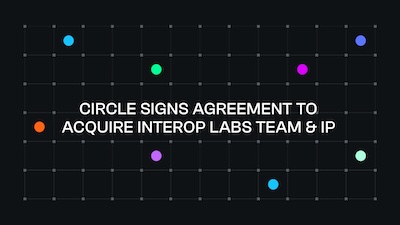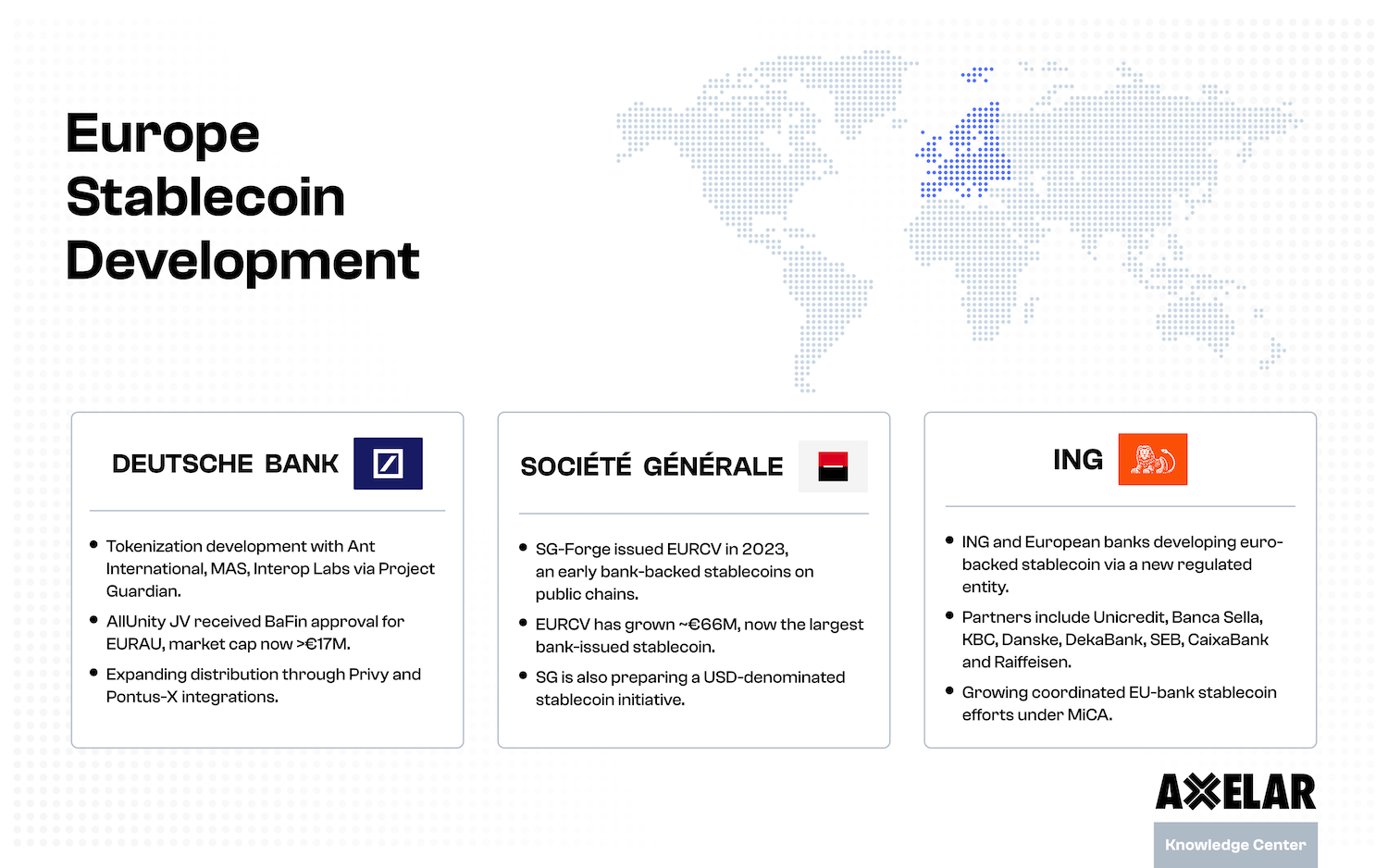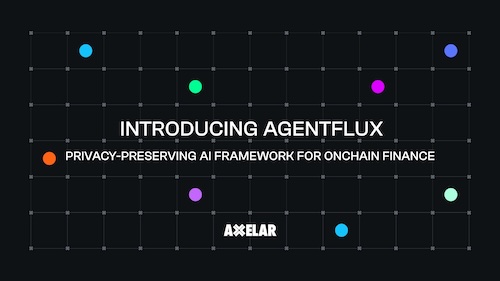In New ‘Interoperability Insights’ Paper, Top Institutions Point to Blockchain Interoperability as Critical to Asset Tokenization
Table of Contents


Today, Axelar Foundation in collaboration with Metrika published a white paper, “Institutional Interoperability: How Financial Institutions Navigate a Multichain World.”
Financial institutions Citi, Deutsche Bank, Mastercard and Northern Trust contributed insights to the paper in spotlight sections. Topics covered include descriptions of their projects in asset tokenization, points where they have implemented multiple blockchains, and potential requirements and challenges for blockchain interoperability. Centrifuge, a Web3 innovator and one of the leading platforms delivering asset tokenization capabilities for institutions, also contributed a spotlight section to the paper. Metrika contributed a section on risk assessment.
All institutions participating in the paper emphasized the need for interlinked network models that embrace multiple blockchains, as well as traditional systems, in order to realize this potential.
Tokenized assets, also known as “real-world assets” (RWAs), are blockchain-based representations of financial assets such as real estate, currencies or securities. A recent report authored by Boston Consulting Group and market operator ADDX predicts multi-trillion-dollar value in tokenized assets within the decade.
The main body of the paper acts as a road map for financial institutions developing tokenized-asset opportunities and facing a complex array of blockchains public and private, alongside stringent requirements imposed by clients and regulations. It was authored by blockchain analyst Emily Parker, based on a framework laid by the Monetary Authority of Singapore (MAS) in a 2023 Project Guardian technical white paper, “Interlinking Networks.”
Axelar network has become trusted infrastructure for institutions exploring asset tokenization: for two years consecutively, MAS Project Guardian initiatives have chosen Axelar for interoperability technology. This blog post summarizes some of the key points in the main body of the paper, and describes ways in which Axelar is working to provide solutions to these institutional challenges and requirements.
Open networks for flexible compliance and security
Improved global access is a key benefit of tokenized assets – but how can regulated financial institutions create systems that operate across borders, in compliance with the various regulations in place in each jurisdiction?
Additionally, the paper discusses how institutions can mitigate risk and meet various client requirements for risk management, using a flexible and multi-layered security approach.
“A multi-layered approach to cross-network risk management is advised – with policies in place that mitigate damage when faults occur. A multi-layered risk management approach should include the capability to customize application-level security policies.”
Axelar’s solution: programmable interoperability
Cross-chain networks use various methods to verify transactions that run between blockchains. For example, some use m of n multisigs, where a group of validators is designated by the developer team that created the cross-chain protocol.
Only Axelar is a blockchain that connects blockchains. Its dynamic validator set operates on the same principles as Ethereum. This supports the security of the network generally, and enables custom configurations at the cross-chain layer – because Axelar itself is programmable.
Therefore, all three of the example customizations cited in the paper are possible on Axelar:
- Additional validation policies for large transfers or transfers from specific accounts.
- Rate limits that cap the amounts that can be transferred over a set time period.
- Limits on repeat transactions or other red-flag patterns.
Network topology design considerations for scalability & security
“Network topology” refers to the way nodes are configured on a network. It’s a concept used in the design of computer networks, as well as physical. In both contexts, topology decisions impact economies of scale as networks grow.
The Institutional Interoperability white paper discusses trade-offs between two topology approaches: hub-and-spoke and point-to-point, or pairwise. On a hub-and-spoke network, messages are routed through a single hub. Pairwise networks relay messages from one node to another.
Each has its advantages. A pairwise network may be able to connect new nodes at a lower cost. On networks where security is critical, hub-and-spoke provides visibility across the network, which is ideal for rapid isolation of problem connections. …
For a pairwise network to connect N nodes, the number of potential connections grows exponentially with the number of nodes. (The formula is N(N-1)/2.) Thus, a pairwise INM that connects five blockchains will require up to 10 connections – and a pairwise INM that connects 100 blockchains will require up to 4,950.
Axelar’s solution: hub-and-spoke topology

Axelar is built on a hub-and-spoke design that enables swift mitigation of security vulnerabilities, and supports efficiencies at scale. This is one of the keys to secure and scalable interoperability.
Publicly verified blockchains are a powerful approach to security. However, vulnerabilities at the smart-contract and protocol layers can put funds at risk. The Institutional Interoperability paper describes these risk categories in detail.
If a connected blockchain, asset or application becomes compromised, a cross-chain network can become a vector for contagion. This is one of the reasons why Axelar is built on hub-and-spoke: problems on connected blockchains are quickly mitigated, while other connections stay live, liquid and safe. The collapse of the Multichain network in 2023 provided a case study of how hub-and-spoke keeps funds safe during emergencies.
Hub-and-spoke topology is equally vital for Axelar’s scalability. Axelar already connects more chains than any other cross-chain network. The Interchain Amplifier will soon deliver automated and permissionless new-chain connections, widening the gap.
On a hub-and-spoke network like Axelar’s, new chains are immediately connected to every other connected blockchain on the network. The number of required connections scales linearly on a 1:1 relationship: i.e., 100 connected blockchains require only 100 connections for full network effects and connectivity across all connected blockchains.
Adaptability and preventing vendor lock-in
The Institutional Interoperability paper discusses the MAS white paper’s recommendation that cross-chain networks deliver “a readily available network of high-quality nodes” – discussing potential pathways to allow this network to adapt as blockchain verification technologies advance in the future.
A readily available network of high-quality nodes is a good starting point today. However, new connections, increased volume and advancements in blockchain technology are likely to demand improvements to this network in the future. This represents a challenge: will applications need to be updated with each future upgrade?
Axelar’s solution: ‘future-proof’ interoperability

The paper references a concept put forward by Interop Labs, the initial developer of Axelar network: “future-proof interoperability.” Using this approach, Axelar operates as a cross-chain network on three layers – as outlined in a 2023 blog post written by Interop Labs CEO and Axelar protocol co-founder Sergey Gorbunov:
- Message semantics simply refers to the structure of messages or packets (API) that applications can use to send messages from one network to another. They're simple and often include fields like source chain, source address, destination chain, destination address, and payload. Applications send and receive messages following the semantics.
- Validation refers to the trust layer. It may be instantiated using a direct light-client based connection, external validation, or any other technology. Application security holds, so long as the validation layer holds.
- Transport: the transport layer is responsible for determining the route from a source to the destination and following it. It’s defined by the routing properties (pairwise, many-to-many) and relaying mechanics (permissioned vs permissionless). It may rely on an on-chain routing table or an off-chain registry.
With consistent message semantics, a network like Axelar can update the validation and transport layers, with no changes required for connected applications. Blockchain verification technology is advancing quickly; the many protocols integrating zero-knowledge (ZK) proofs serve as examples. In order to adapt and adopt at the cross-chain layer, without upgrade headaches for connected applications, a layered approach like Axelar’s is required.
Compliance risk: money-laundering over bridges
Hacks are not the only threats to INM security. Another is money laundering. According to a 2023 report by Elliptic, a blockchain forensics firm, $7 billion in crypto has been laundered through cross-network services. Blockchain proponents will argue that the relative transparency of blockchain technology actually makes it easier to track criminal activity – but the Elliptic report revealed opacity in some cross-network connections as a weak link in the audit trail.
This is not viable for blockchain interoperability to succeed in an institutional context. Active monitoring of cross-network activity is necessary from end to end. The MAS report emphasizes the need for verification of cross-network transactions by an independent network that can detect anomalies.
Axelar’s solution: an open and transparent network
Here is another advantage of Axelar’s unique status as a blockchain that connects blockchains. Other bridges and blockchain networks include off-chain components: black boxes that can be used to launder funds.
This would not be possible on Axelar, where transactions are visible end-to-end, from source chain to destination. This openness aids in transaction monitoring and transparency – and also underpins Axelar’s configurability for a variety of institutional finance regulatory and security requirements.
Conclusion: network design matters
Institutional requirements for connecting across public and private blockchains are as diverse as the financial products these institutions could soon create using asset tokenization. They span jurisdictional compliance and a wide range of client needs.
Axelar is built from the ground up to be secure, scalable and open – an approach that has required thoughtful design and expert engineering. The result is a network that delivers:
- Flexibility to meet the compliance requirements of various jurisdictions and the security requirements of various clients, with an open network supporting programmable interoperability and custom configuration at the cross-chain layer.
- Hub-and-spoke topology to mitigate the impact of security incidents and rapidly scale the network across many additional connections.
- A consistent message-semantics layer that allows the underlying security and transport layers to advance technologically without requiring connected applications to upgrade.
- An open and transparent network that provides end-to-end visibility into cross-chain paths, preventing money-laundering that historically some bridges have enabled.
To learn more about institutional considerations and challenges in blockchain interoperability and read the spotlights contributed by large financial institutions, download the Institutional Interoperability white paper.


